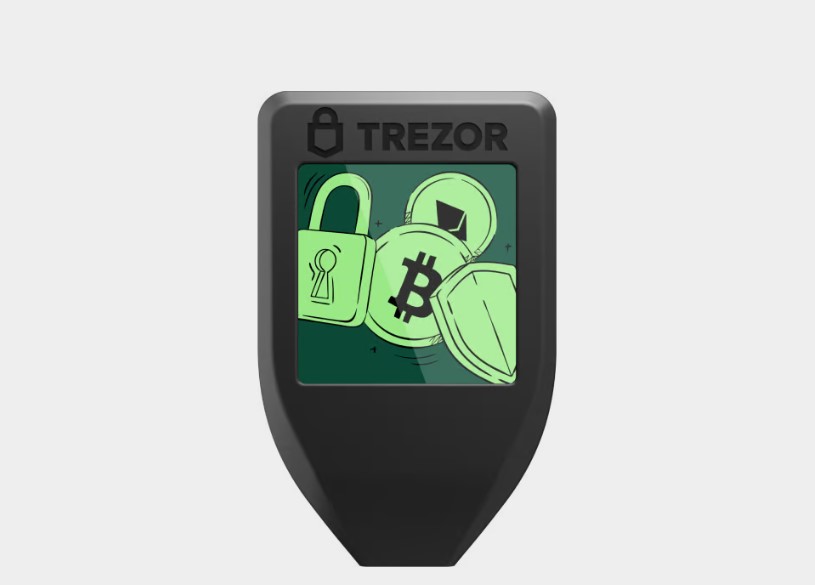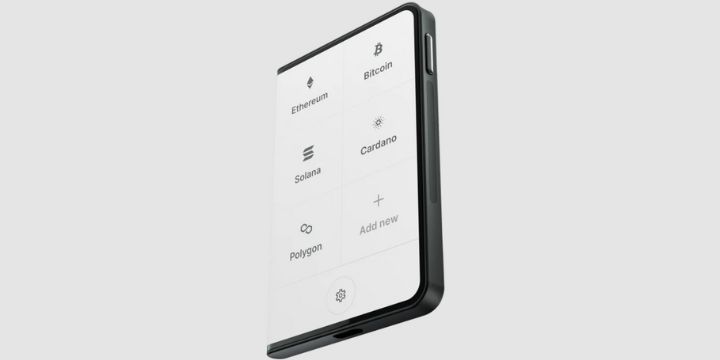Choosing a hardware wallet is difficult when Ledger and Trezor are your only options. These two are leading hardware wallet brands available for digital assets. Both have outstanding features and top-notch security.
So, which of the two should you go for when shopping for a cold wallet? Here’s a Ledger vs Trezor comparison article to help you out.
Key Takeaways:
- Trezor Model T has a bigger, more colorful touchscreen, while Ledger Nano X has a smaller, greyscale OLED screen.
- Ledger Nano X and Ledger Stax have Bluetooth and a mobile app, while Trezor doesn’t.
- Ledger uses closed-source firmware, while Trezor uses open-source firmware.
Ledger vs Trezor: Key Differences
There’s a lot to consider when comparing Ledger vs Trezor wallets. Factors like price, physical design, model comparison, compatibility, security features, and customer support are important to analyze before making the final decision. Let’s explain these factors and point out the best wallet under each criterion.
| Ledger | Trezor | |
| Price | $79 to $279 | $69 to $219 |
| Compatibility | 50+ walletsWindows, Mac OS and Linux | Unlimited hidden walletsWindows, Mac OS and Linux |
| Supported Currencies | 500+ coins from Ledger Live App5000+ coins from third-party wallets | 1456 coins on model T1289 coins on model One |
| NFTs | Yes | Yes |
| Staking | Support | Support |
| Connectivity | Bluetooth, except Nano S PlusUSB-C for all model | USB-C for Model TUSB-A for Model One |
| Mobile App | Yes (Ledger Live) | Yes (only android) |
Ledger vs Trezor: Similarities
- Ledger and Trezor both have desktop apps and built-in swaps for convenience.
- They both let users have a primary account and some secret accounts with the same 24-word recovery phrase.
- They both offer a touchscreen model: Ledger Stax and Trezor Model T.
- They both connect with a USB cord and have a PIN protection option.
- Ledger and Trezor support integration with software wallets like MetaMask, Atomic Wallet, etc.
Ledger Wallets: Best Crypto Cold Storage Solution
![Ledger vs Trezor: Which One Should You Use? (Updated [currentyear]) 23 ledger wallet homepage](https://coinwire.com/wp-content/uploads/2023/03/ledger-wallet-homepage-1024x478.jpg)
Ledger Wallet is a brand name for one of the most popular hardware cryptocurrency wallets. The brand has several models, including Ledger Nano S Plus, Ledger Nano X, and Ledger Stax.
The Ledger Nano S Plus is an affordable option to secure your cryptocurrency and NFTs. It comes with a small screen and USB-C connection and weighs 21 grams. The Ledger Nano X is designed for mobile use and offers Bluetooth connectivity and features similar to the Nano S Plus.
The Ledger Stax is the most advanced model, with a curved E Ink touchscreen, wireless charging, and embedded magnets. It weighs 45.2 grams and has a larger size compared to the other models.
Here are some pros and cons of using this hardware wallet.
Pros of Ledger Wallet
- Most secure hardware wallet
- Allows users to exchange and even grow their cryptocurrency holdings and NFTs
- More affordable than most brands
Cons of Ledger Wallet
- Some models do not support buying cryptocurrencies.
- Certain models have very limited storage.
Trezor Wallets: Best Hardware Wallet for Bitcoin
![Ledger vs Trezor: Which One Should You Use? (Updated [currentyear]) 24 trezor wallet homepage](https://coinwire.com/wp-content/uploads/2023/03/trezor-wallet-homepage-1024x476.jpg)
Trezor Wallet is another leading cold storage wallet for digital assets. Cold storage wallets are the same as hardware wallets. Like Ledger Wallet, Trezor is also a brand name. Under the brand, users will find the Trezor Model T and Trezor Model One models.
The Model One is the original and affordable Trezor wallet. It has a simple design with two buttons and a screen. It is small, lightweight, made of plastic, and has a micro USB port.
The Model T is a premium and advanced Trezor wallet. It has a sleek design with a touchscreen and USB-C port. It offers unique features like enhanced privacy with Coinjoin, improved recovery with Shamir Backup, and extra storage with an SD card slot. It is slightly larger and heavier than the Model One, made of plastic with a magnetic dock.
Let’s explore some of the pros and cons associated with Trezor Wallets.
Pros of Trezor Wallet
- Allows users to buy, sell, receive, and monitor their crypto assets
- Supports a wide range of tokens
- Enables users to purchase crypto by using fiat
Cons of Trezor Wallet
- It is more expensive than other brands.
- It has a bulkier design than other brands.
1. Ledger vs Trezor: Price Comparison
Ledger and Trezor hardware wallets have a significant price difference. The most affordable of these two models is Trezor. The most recent Trezor model, Trezor T, costs about $219.00, while the older model, Trezor One, goes for $69.
On the other hand, Ledger’s newest model, Ledger Stax, is worth $279. The other two models, Ledger Nano X and Ledger Nano S Plus, cost $149 and $79, respectively.
| Model | Price |
| Ledger Nano S Plus | $79 |
| Trezor Model One | $69 |
| Ledger Nano X | $149 |
| Trezor Model T | $219 |
| Ledger Stax | $279 |
Winner: Trezor
2. Trezor vs Ledger Wallet: Model Comparison
Trezor and Ledger wallets both have several models. For each brand, one of the models is an advancement of the other. These advancements may impact the accessibility and use of wallets, but they hardly affect security. Let’s compare each brand’s model to the others to see what benefits users get.
Ledger Nano S Plus vs Trezor One
![Ledger vs Trezor: Which One Should You Use? (Updated [currentyear]) 25 ledger nano s plus vs trezor one](https://coinwire.com/wp-content/uploads/2023/03/ledger-nano-s-plus-vs-trezor-one-1024x512.jpg)
Trezor Model One and Ledger Nano S Plus are the flagship models for Trezor and Ledger wallets. These crypto wallets were the pioneers, so some of their features may be less advanced than later models. Still, these wallets have some of the best security features that future models have borrowed. However, their significant downside is that they may have less advanced interfaces and storage.
The most outstanding trait of the Ledger Nano S Plus is its affordability. This wallet costs about $79, which is lower than most cold storage wallets. Besides, its price does not affect its features. Besides, its price does not affect its features.
Even at this affordable price, the Ledger Nano S Plus still has high-level security and supports at least 500 currencies. However, its major shortcoming is that it misses out on many advanced physical features of newer models. For instance, it only has a static screen and lacks Bluetooth connection and wireless charging.
On the flip side, Trezor Model One is popular for the wide range of assets it supports. The wallet grants access to over 1,200 crypto assets and allows users to purchase crypto using fiat. However, this wallet does not support iOS, which is one of its most significant flaws.
Here’s a feature-by-feature breakdown for each wallet.
| Trezor Model One | Ledger Nano S Plus | |
| Supported Currencies | 1200+ | 5500 + |
| Cost of Purchase | $69 | $79 |
| Display Size | 60mm x 30mm x 6mm; 12 grams | 62.39 x 17.40 x 8.24mm; 21 grams |
| Material | Stainless Steel with Plastic Parts | Brushed stainless steel and plastic |
| Accessibility | Desktop (Windows, Linux, Mac)Browser | Desktop (Windows, Linux, Mac) Android 9+ |
| Connectivity | Micro USB | USB-C |
Winner: Ledger S Plus
Ledger Nano X vs Trezor Model T
![Ledger vs Trezor: Which One Should You Use? (Updated [currentyear]) 26 ledger nano x vs trezor model t](https://coinwire.com/wp-content/uploads/2023/03/ledger-nano-x-vs-trezor-model-t-1024x683.jpg)
If you are looking for a top-notch hardware wallet to store your crypto assets, you can go right with either Ledger Nano X or Trezor Model T.
They both have a lot of features and functions in common. But Ledger Nano X stands out with its Bluetooth feature, mobile app compatibility, a wider range of supported coins, and cheaper price tag.
Trezor Model T has unique perks, like a color touchscreen and fully open-source firmware.
| Trezor Model T | Ledger Nano X | |
| Supported Currencies | 1400+ | 5500 + |
| Cost of Purchase | $219 | $149 |
| Display Size | 64 mm x 39 mm x 10 mm | 72mm x 18.6mm x 11.75mm |
| Touchscreen | Yes | No |
| Accessibility | Desktop (Windows, Linux, Mac)Browser | Desktop (Windows, Linux, Mac) Android 9+ |
| Connectivity | USB-C | USB-C and Bluetooth |
Winner: Ledger Nano X
Ledger Stax vs Trezor Model T
![Ledger vs Trezor: Which One Should You Use? (Updated [currentyear]) 27 ledger stax vs trezor model t](https://coinwire.com/wp-content/uploads/2023/03/ledger-stax-vs-trezor-model-t-1024x512.jpg)
Ledger Stax and Trezor Model T are the more recent models for each brand. These advanced models resolved some of the issues that their predecessors had. They, for instance, have more advanced designs and are simpler and beginner-friendly.
An excellent example is the Trezor Model T. This model is known for simplifying transactions and managing crypto assets. The wallet has a touchscreen interface, over 1,400 cryptocurrencies, and an easy set-up process that beginners would appreciate. On the flip side, though, the wallet is more expensive than its past versions and considerably bulkier.
On the other hand, Ledger Stax is known for its sleeker design. The wallet has a comfortable palm-size design, touchscreen capabilities, and wireless charging. These characteristics make the wallet easier to carry and operate. Additionally, it can store NFTs. Ledger Stax is user-friendly and supports at least 500 coins from the Ledger Live APPs and over 5000 from partnering wallets. However, its major flaw is that it is significantly more expensive.
Here’s a feature-by-feature breakdown for each wallet.
| Trezor Model T | Ledger Stax | |
| Supported Currencies | 1400+ | 500+ coins from Ledger Live App5000+ coins from third-party wallets |
| Cost of Purchase | $213 | $279 |
| Display Size | 64 mm x 39 mm x 10 mm | 85mm x 54mm x 6mm; 45.2 grams |
| Touchscreen | Yes | Yes |
| Material | Stainless Steel with plastic Parts | Aluminum and plastic with embedded magnets for stackability |
| Accessibility | Desktop (Windows, Linux, Mac)Browser | Desktop (Windows, Linux, Mac)iOS 13+Android 9+ |
| Connectivity | USB-C | USB-CBluetooth |
Winner: Ledger Stax
3. Ledger and Trezor: Compatibility Comparison
Crypto hardware wallets need to be compatible with several devices, operating systems, hot wallets, and other technologies that may make them more efficient. Regarding Leder and Trezor, both wallets score highly in compatibility.
Trezor suite wallets are compatible with multiple operating systems, including Mac OS, Windows, and Linux. These wallets also support unlimited software wallets, a browser application, and Bluetooth connectivity. However, Trezor wallets don’t have a mobile app, though they will soon release an Android application.
Conversely, Ledger wallets support Mac OS, Windows, and Linux. They are compatible with multiple digital wallets and can connect to Bluetooth networks. Their most significant benefit is that they have Android and iOS mobile apps for all models, aside from the Ledger Nano S Plus, which supports only the Android application.
Winner: Ledger
4. Ledger vs Trezor: Supported Coins
Across the board, Trezor and Ledger Wallets support over 3,000 cryptocurrencies. When broken down, however, it is easy to spot that the Ledger wallet has a wider variety of coins. Let’s analyze the cryptocurrencies that each wallet supports.
Winner: Ledger
Wallets and Cryptocurrencies Supported on Ledger
Ledger wallets support at least 50 other crypto wallets, including Electrum, Mycrypto, MyEtherWallet, Electron Cash, PolkaDot JS, Binance, and Cosmostation. Such a wide range of partner wallets ensures that Ledger devices can access some of the most in-demand coins. Here’s a list of the ten most popular coins you can access using a Ledger wallet.
- Bitcoin (BTC)
- Ethereum (ETH)
- Polkadot (DOT)
- Binance Coin (BNB)
- Tether USD (TRC20) (USDT)
- Monero (XMR)
- Cardano (ADA)
- Stellar (XLM)
- Dogecoin (DOGE)
- Ripple (XRP)
![Ledger vs Trezor: Which One Should You Use? (Updated [currentyear]) 28 list of supported coins on ledger](https://coinwire.com/wp-content/uploads/2023/03/list-of-supported-coins-on-ledger.png)
Wallets and Cryptocurrencies Supported on Trezor
Trezor also supports several cryptocurrencies. However, the Trezor One model has a limited range of coins. For instance, the model does not support some of the most popular altcoins like Monero, Cardano, and Ripple, which are all available on both Ledger models. Still, the brand has a ton of coins to explore. Here’s a breakdown of the ten most popular cryptocurrencies supported on Trezor.
- Bitcoin (BTC)
- Ethereum (ETH)
- Tether USD (TRC20) (USDT)
- Binance Coin (BNB)
- USD Coin (USDC)
- Binance USD (BUSD)
- Ripple (XRP)
- Dogecoin (DOGE)
- Cardano (ADA)
- Polygon (MATIC)
5. Ledger vs Trezor: Staking Options
Staking crypto on a hardware wallet comes with some benefits. Unlike staking on an exchange, where investors have to pay a fee for staking, hardware wallets offer taking services at no additional cost. This is why Ledger and Trezor are considered as some of the best staking wallets to explore.
Ledger Wallet has a broader range of coins to stake. Here’s a list of the cryptos you can stake in the wallet.
- Ethereum (ETH)
- Terra (LUNA)
- Tron (TRON)
- Cardano (ADA
- Nem (XEM)
- Cronos (CRO)
- Cosmos (ATOM)
- Internet Computer (ICP)
- Elrond (EGLD)
- Algorand(ALGO)
- Neo (NEO)
- Tezzos (XTZ)
- EOS (EOS)
On the other hand, Trezor suite supports staking for fewer but rare crypto assets. Here’s a list of crypto assets you can stake on Trezor.
- Algorand
- Solana
- Cosmos
- Cardano
- Ontology
- Tezos
- Vechain
Staking rewards depend on the platform you choose to stake your crypto on. These rewards have nothing to do with the hardware wallet except that different wallets give access to various platforms where you can stake.
Winner: Ledger
6. Ledger vs Trezor: Security
![Ledger vs Trezor: Which One Should You Use? (Updated [currentyear]) 29 ledger structure](https://coinwire.com/wp-content/uploads/2023/03/ledger-structure-1024x453.png)
Another dominant feature to analyze between Trezor and Ledger is security. Both wallets are known to be very secure. However, slight variations may seem favorable depending on a specific user’s demands.
Trezor has a very robust security system. One of the wallet’s most outstanding security features is its Shamir backup setting. This security protocol protects your seed phrase from destruction and theft. The Trezor wallet also applies the Bitcoin Improvement Proposals. This high-level security feature enables users to add an extra password phrase to the existing seed phrase.
On the other hand, Ledger wallets have Bankrate Secure Elements (SE). These are secondary chips that ensure the wallet is secure from attacks. These wallets also use BIP39 passphrases, and unlike Trezor suite open-source wallets, they have closed-source firmware, meaning their programs are not accessible to third parties.
Winner: Tie (Both are highly secure)
Related Article: Best DeFi Wallets to Store Your Cryptos in 2024
7. Ledger vs Trezor: Ease of Use
Which hardware wallet is easier to use, between Ledger and Trezor? Both wallets have their strengths, but Ledger takes the lead. While the latest Trezor model has a color touchscreen display that makes navigation more manageable, it does not have a mobile app. This means users must constantly be around a PC or desktop to use the wallet, making it cumbersome for most users.
On the other side of the scope, Ledger’s latest model, the Stax, has a colored touchscreen display and a mobile application for Android and iOS users. Additionally, Ledger Stax has other advanced features like a longer-lasting battery, wireless charging, a palm-sized design, and a sleek surface that makes it easily portable.
Winner: Ledger
Ledger vs Trezor: How to Set Up?
How to Set up Ledger Devices?
- Get the Ledger Live app on your phone or computer.
- Plug in your Ledger device to your phone or computer and follow the screen instructions to set up a new device or restore an old one.
- Pick a PIN code to lock your device and confirm it.
- Copy your recovery phrase on the recovery sheet and keep it in a secure place. This is a backup of your device that you can use to recover your accounts if your device gets lost or broken.
- Install the apps for the crypto assets you want to use on your device using Ledger Live. You can install up to 100 apps, depending on the size of each app.
- Add your accounts to Ledger Live to see and manage your crypto assets. You can also buy, swap, lend, and access other services with Ledger Live.
How to Set up Trezor Devices?
- Connect your Trezor device to your computer and open trezor.io/start in your browser.
- Choose your Trezor model and install the firmware by following the instructions on the screen.
- Choose ‘Create new wallet’ or ‘Recover wallet’ depending on whether you have a backup or not.
- Create a backup of your recovery seed by writing down the words displayed on your device on the card provided.
- Set up a PIN to protect your device by using the blind matrix keypad on the browser and the device screen.
- Name your device and choose a passphrase if you want extra security.
- Enjoy using your Trezor device with Trezor Suite or other compatible apps.
Final Thoughts
In this Ledger vs Trezor review, we compare both based on various factors. Both wallets are excellent options for digital assets cold storage. The best wallet depends on your preferences, budget, and needs.
Trezor is more affordable than Trezor’s basic version. However, Ledger supports more coins and more 3rd party apps storage space.
Some users may like the openness of Trezor’s open-source software, while others may trust the security of Ledger’s closed-source software more.
FAQs: Ledger vs Trezor
Which should I choose, Trezor or Ledger?
The choice of a hardware wallet depends mainly on your needs as a user. Ledger wallets have more security features and are regulated by the ANSII. They also have a sleeker design and more cryptocurrency options for staking. On the other hand, Trezor wallets have access to rare coins and connect to software like Exodus Wallet, which offers impressive returns.
Ledger vs Trezor: Which is safer?
Ledger wallets are safer than Trezor ones. These wallets are regulated by the ANSII. They also have closed-source firmware that prevents third parties from accessing their programming. Additionally, Ledger wallets have secondary Bankrate secure element chips for an extra layer of protection. The features are absent in Trezor wallets.
Trezor or Ledger, Which Is cheaper?
The Trezor Model One wallet costs $69, while the Trezor Model T costs $219. Ledger wallets are relatively cheaper, with the Ledger Nano S Plus going for $79 and the Ledger Stax retailing at $279.
What is the advantage of Ledger Nano X over Trezor Model T?
Ledger Nano X has some features that Trezor Model T lacks, such as the ability to connect to your phone via Bluetooth, support for more than 5,500 coins, and a dual-chip design with a secure element. These features give Ledger Nano X more convenience, compatibility, and security than Trezor Model T.
Why is Trezor safer than Ledger?
Trezor has some benefits that Ledger does not have, such as having its firmware open to the public, while Ledger’s firmware is closed and proprietary. This means anyone can check and verify Trezor’s code, while Ledger’s code is hidden and secret. Another benefit of Trezor is that it provides Shamir Backup, which lets you divide your recovery seed into multiple pieces and store them in different places. This adds more protection in case you lose or damage your device.
Can Ledger or Trezor wallets be hacked?
Both Ledger and Trezor hardware wallets are made to be very safe and hard to hack. However, no device is completely perfect and there are some possible risks and weaknesses that could affect your funds.
For example, if you misplace your device or your recovery seed, you could lose your funds. If you type your pin or seed on an infected computer or phone, you could reveal your private keys to malware or phishing attacks. If you purchase a fake or altered device from an unreliable source, you could be exposed to a supply chain attack.
Therefore, it is important to follow some best practices when using a hardware wallet, such as:
- Buy your device only from the official website or authorized resellers
- Always check the authenticity and integrity of your device before using it
- Keep your device and software updated with the latest firmware and security patches
- Use a strong pin and store your recovery seed in a safe and secret place
- Never type your pin or seed on any device other than your hardware wallet
- Never share your pin or seed with anyone
Elevate your crypto trading career with CoinWire Trading signals. Get Premium daily signal calls, trading insight, updates about the current market, and analytics about hidden crypto gems now.










